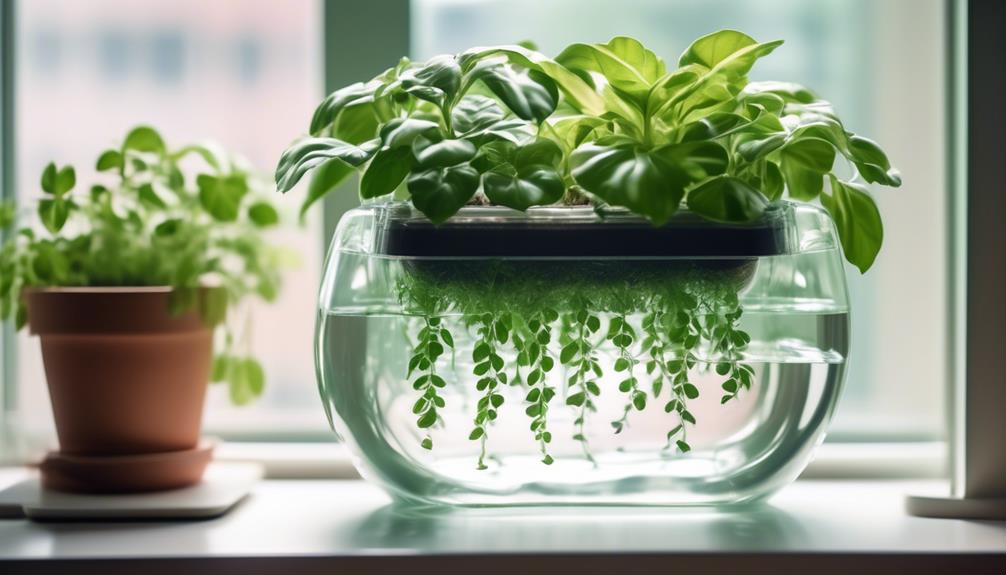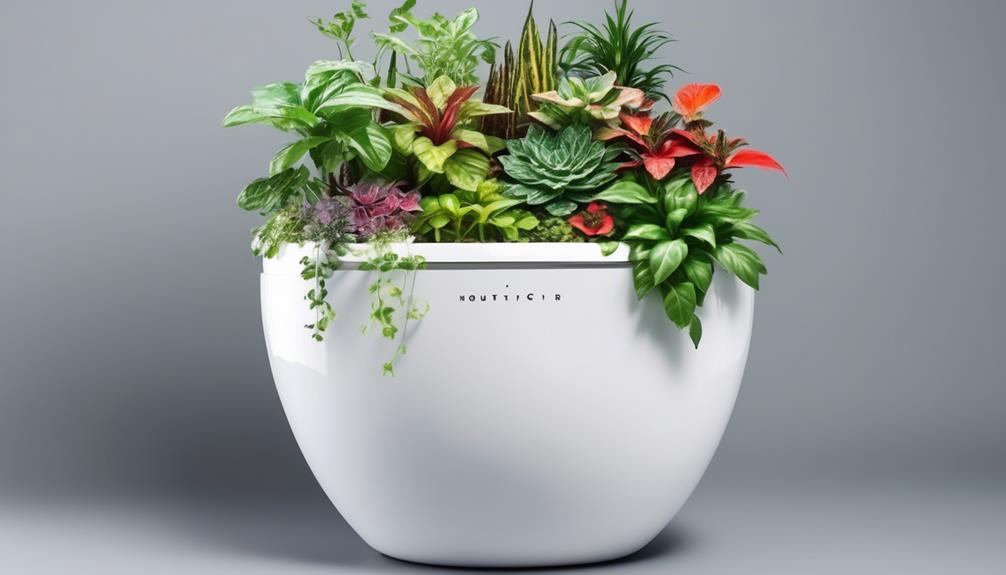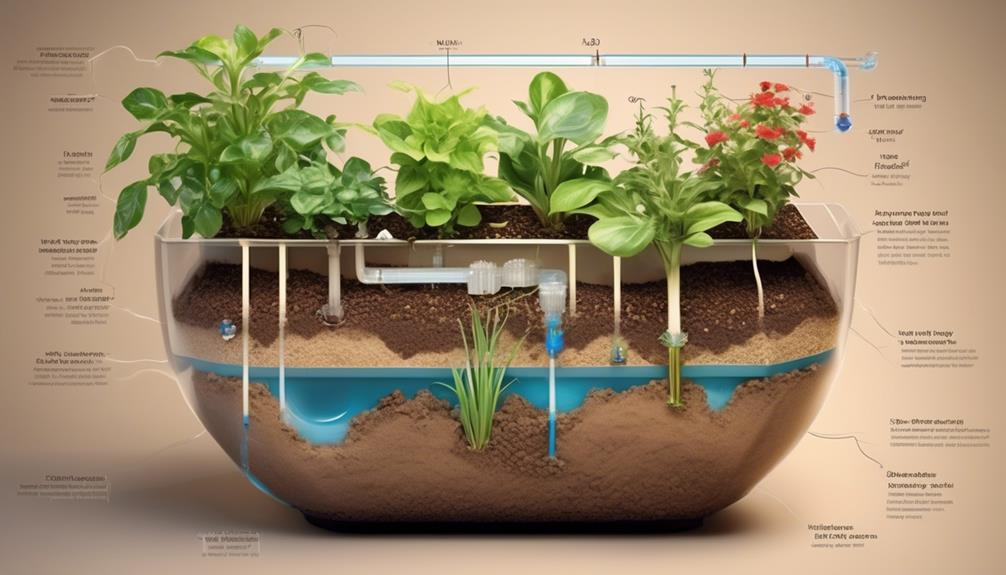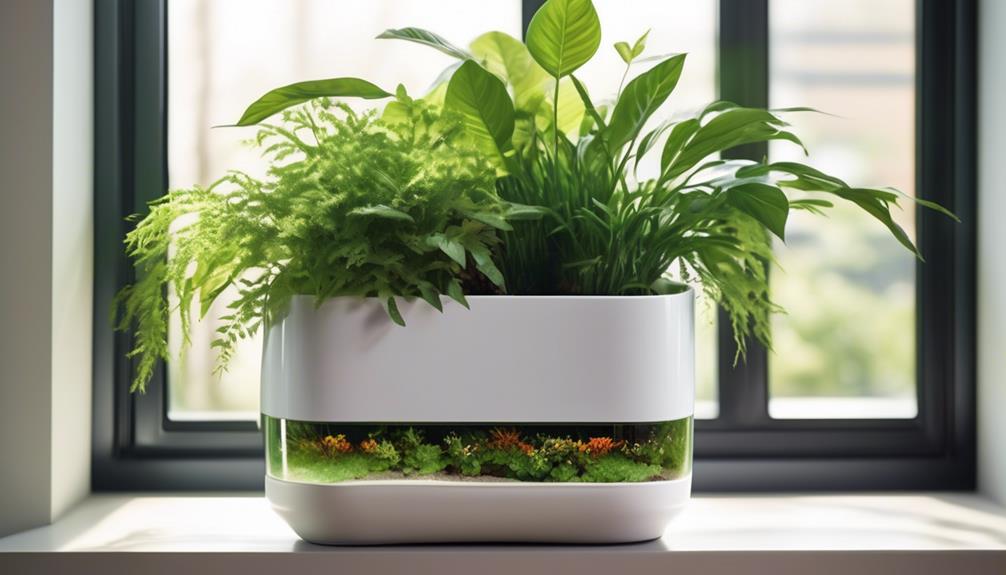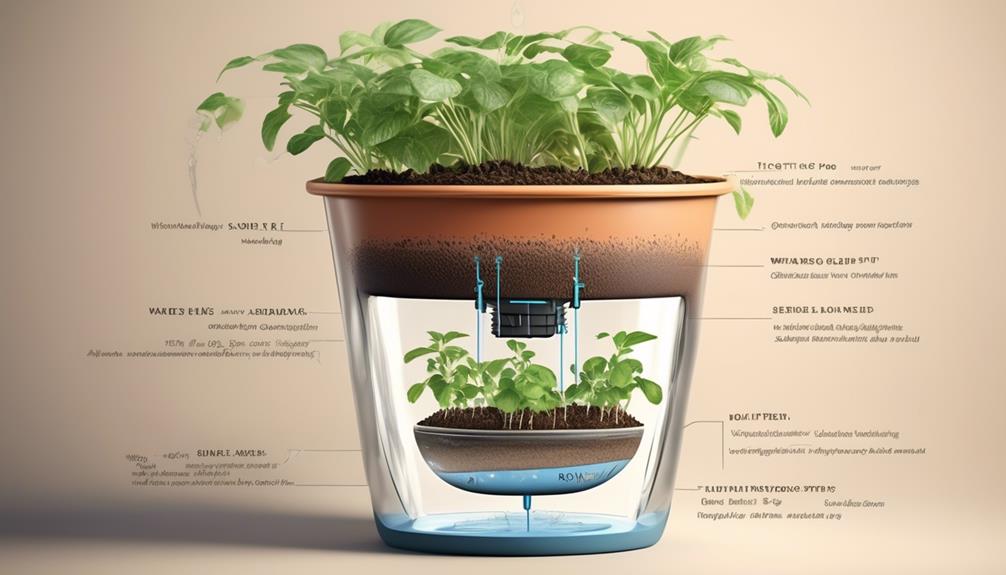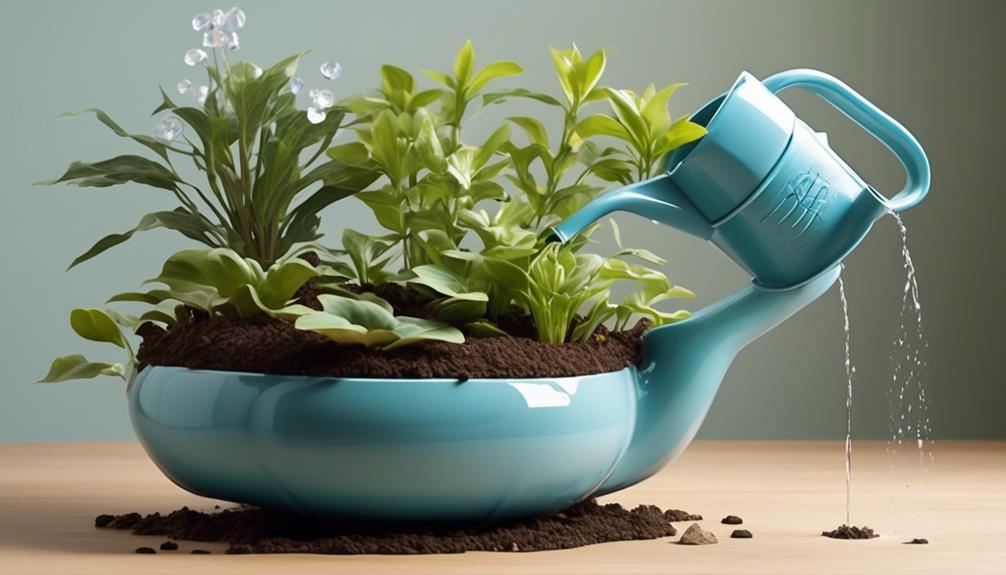We’ve all experienced that feeling of juggling work duties, family commitments, and social engagements, just to realize we’re neglecting our houseplants due to lack of time.
Did you know that over 75% of indoor plants die from improper watering?
But what if I told you there's a solution that could potentially change the game?
Indoor self-watering plant pots have been gaining traction for their convenience and efficiency, but are they really all they're cracked up to be?
Let's explore the world of indoor self-watering plant pots and see if they live up to the hype.
Key Takeaways
- Self-watering plant pots provide a consistent water supply to prevent under or over-watering.
- They are convenient for individuals with busy schedules or limited mobility.
- Self-watering pots reduce maintenance frequency and effort.
- They promote healthier root systems and plant growth.
Advantages of Self-Watering Plant Pots
Self-watering plant pots offer numerous benefits for maintaining healthy and vibrant plants with minimal effort. The efficiency of these pots lies in their ability to provide a consistent water supply to the plants, preventing under or over-watering. This is particularly advantageous for individuals who may forget to water their plants regularly.
The convenience of self-watering pots is evident in their ability to sustain plants for extended periods, reducing the frequency of maintenance. By allowing the soil to draw water as needed, these pots promote healthier root systems and overall plant growth.
One of the main benefits of self-watering plant pots is their ability to save time and effort for individuals who may have busy schedules or limited mobility. These pots also minimize the risk of water-related issues such as waterlogging, which can lead to root rot and other plant diseases. Additionally, they can be particularly useful for plants that require consistent moisture levels, such as tropical or aquatic plants.
However, it's important to note that self-watering pots may have drawbacks, such as the potential for algae growth in the water reservoir and the initial cost of purchasing these specialized pots.
Types of Indoor Self-Watering Pots
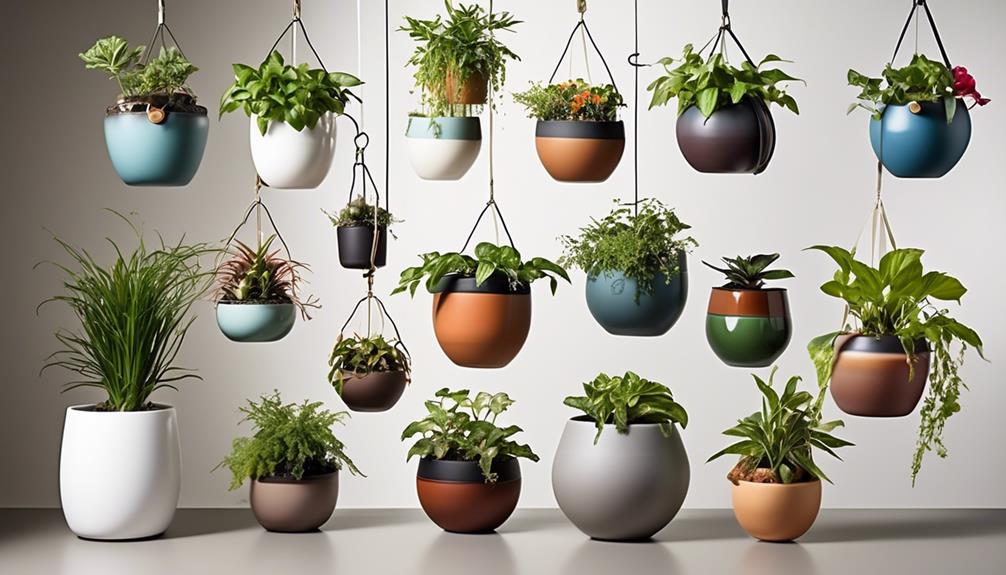
With the advantages of consistent water supply and reduced maintenance needs in mind, indoor self-watering pots come in various types, each designed to cater to specific plant needs and aesthetic preferences.
When considering self-watering pot materials, it's essential to opt for options like plastic, ceramic, or glass, each with its own set of benefits such as durability, moisture retention, and aesthetic appeal. Plastic pots are lightweight and cost-effective, making them a practical choice for a variety of plants. Ceramic pots, on the other hand, offer better insulation and a more elegant look, while glass pots provide a modern and sleek aesthetic.
Additionally, decorative self-watering pots offer a wide range of designs and styles to complement any interior decor. These pots often feature intricate patterns, vibrant colors, and unique shapes, enhancing the visual appeal of indoor plants while simultaneously providing the necessary self-watering functionality.
Decorative self-watering pots can be a focal point in any room, adding a touch of personality and charm to the space. Whether choosing self-watering pot materials for functionality or opting for decorative options to elevate the aesthetic appeal, there are plenty of choices available to suit individual preferences and plant care needs.
Choosing the Right Plant for Self-Watering Pots
When selecting plants for self-watering pots, it's crucial to consider their specific water requirements and growth characteristics to ensure optimal health and longevity. The choice of the right plant is crucial for the success of the self-watering system.
When it comes to choosing the ideal plant species, consider those with moderate water needs and compact growth habits. Succulents, such as aloe vera and echeveria, are excellent choices due to their ability to store water and thrive in drier conditions. Additionally, herbs like rosemary, thyme, and oregano are suitable options as they prefer slightly drier soil.
Pot size considerations are also important. For smaller self-watering pots, it's best to select plants with slower growth rates and smaller root systems to prevent overcrowding. On the other hand, larger pots can accommodate a wider range of plants, including those with more extensive root systems and higher water requirements.
How to Use Self-Watering Plant Pots
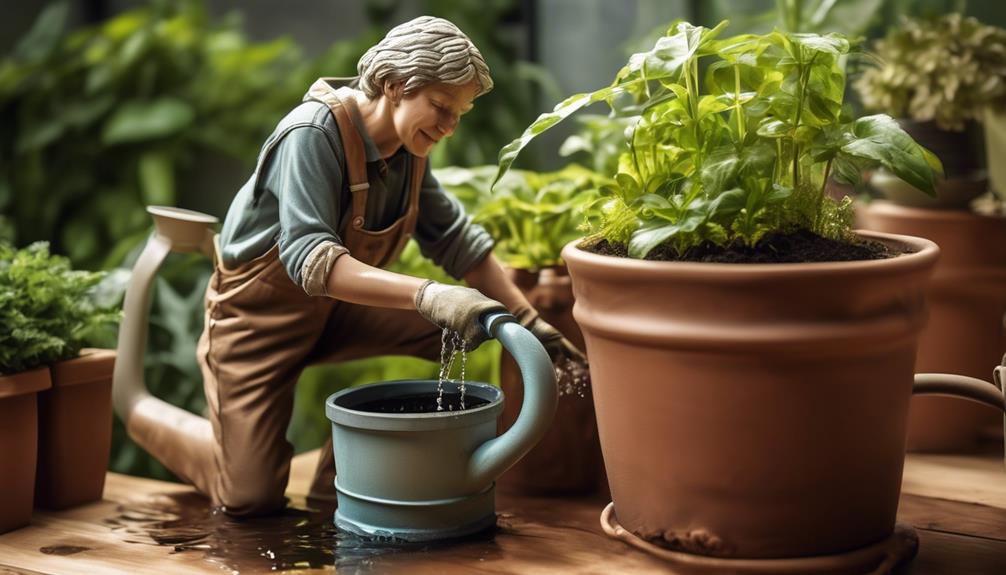
We regularly monitor the water level and refill the reservoir as needed, ensuring consistent moisture for optimal plant growth in self-watering plant pots. Using self-watering plant pots can be a game-changer for plant care, and proper usage is crucial for the health of your plants.
Here's how to make the most of your self-watering plant pots:
- Check Watering Frequency: Regularly check the water level indicator to determine the watering frequency. This ensures that the plants receive an adequate and consistent water supply without overwatering.
- Monitor Soil Moisture: Keep an eye on the soil moisture level to understand the water needs of your plants. This can be done by occasionally checking the soil with a moisture meter or by simply feeling the soil to ensure it's neither too dry nor waterlogged.
- Refill the Reservoir: When the water level indicator is low or the soil moisture is decreasing, refill the reservoir with water. Use room temperature water to prevent shocking the plant's roots and maintain the optimal soil moisture level.
Maintenance Tips for Self-Watering Pots
To ensure optimal functionality and longevity of self-watering pots, regular cleaning and maintenance are essential. One of the best practices for long-term care is to regularly check the water level indicator to ensure that the reservoir is adequately filled.
Additionally, it's important to clean the watering system, including the wick or watering tube, to prevent clogging and ensure proper water distribution to the plant's roots. Troubleshooting tips for common problems include checking the drainage system for any blockages and adjusting the soil moisture levels based on the specific needs of the plant.
Another important maintenance tip is to periodically clean the pot, both inside and out, to prevent the buildup of algae, mineral deposits, or mold, which can affect the water quality and overall plant health. It's also recommended to inspect the pot for any signs of wear and tear, such as cracks or leaks, and address these issues promptly to avoid water leakage or uneven watering.
Frequently Asked Questions
Can Self-Watering Plant Pots Be Used for Outdoor Plants as Well?
Yes, self-watering plant pots can be used for outdoor plants as well. They provide a consistent water supply, reducing the need for frequent watering.
However, it's important to select the right plant types for outdoor use, considering factors like sunlight exposure and climate. Some suitable options include herbs, flowers, and certain vegetables.
Understanding the specific water and sunlight needs of the plants is crucial for successful outdoor use of self-watering pots.
Are There Any Specific Types of Soil or Growing Medium That Work Best With Self-Watering Plant Pots?
The best soil and ideal growing medium for self-watering plant pots are key for maintaining proper watering frequency and ensuring plant health.
The type of soil or medium used should have good water retention properties while still allowing for proper drainage to prevent waterlogging. A balanced mix of peat, perlite, and vermiculite often works well.
This ensures that the plants receive adequate moisture without becoming waterlogged, promoting healthier growth.
Are Self-Watering Plant Pots Suitable for All Types of Indoor Plants, Including Succulents and Cacti?
Yes, self-watering plant pots are suitable for a wide variety of indoor plants, including succulents and cacti. When choosing plants, it's crucial to consider their water requirements and adapt the pot's water level accordingly.
Maintenance tips include checking the water level regularly and adjusting it based on the plant's needs. Additionally, using a well-draining soil mix specifically designed for succulents and cacti can further optimize their growth in self-watering pots.
Can Self-Watering Plant Pots Be Used for Herbs and Vegetables?
Yes, self-watering plant pots can be used for growing herbs and vegetables indoors. They provide a consistent water supply, essential for the growth of these plants.
This method ensures that the soil moisture levels are maintained, which is particularly beneficial for herbs and vegetables.
It's a great option for indoor gardening, providing a convenient means of ensuring that these plants receive the water they need for optimal growth.
How Do Self-Watering Plant Pots Prevent Overwatering and Root Rot?
We've found that self-watering plant pots prevent overwatering and root rot by regulating moisture levels.
The benefits of self-watering pots include a reservoir that allows plants to draw water as needed, reducing the risk of waterlogged soil.
Additionally, aeration and drainage systems help maintain optimal growing conditions.
These features work together to create a balanced environment for plant roots, promoting healthy growth and minimizing the likelihood of overwatering and root rot.
What are the Benefits of Using Self-Watering Plant Pots for Indoor Plants?
Selfwatering indoor plant pots revolutionize plant care by ensuring optimal moisture levels, reducing watering frequency and preventing overwatering. These ingenious containers promote healthy root growth and enhance plant vitality, making them ideal for busy plant lovers and enhancing greenery in any indoor space.
Conclusion
In conclusion, indoor self-watering plant pots are a revolutionary invention that has made plant care easier than ever.
With their advanced technology and efficient design, these pots take the hassle out of watering and provide the perfect environment for your plants to thrive.
So, if you want to enjoy the benefits of having beautiful, healthy plants without the hassle of constant watering, self-watering plant pots are the way to go.
Happy planting!

